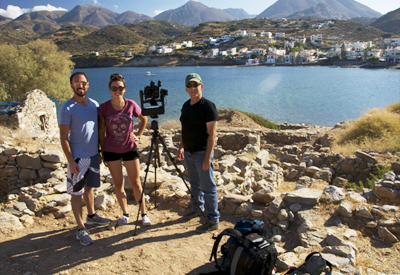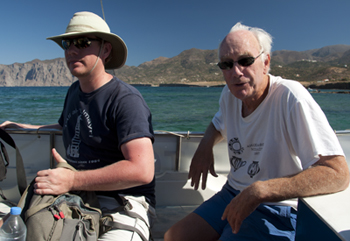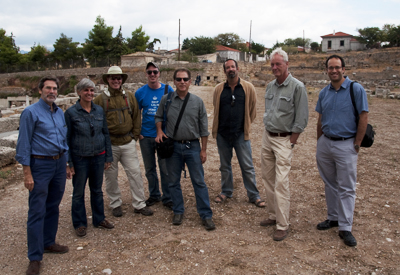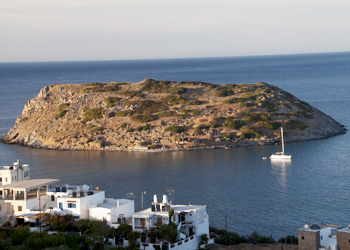Students As Oracles: In Delphi, UC San Diego Researchers Report Cyber-Archaeology Findings
San Diego, Oct. 25, 2013 -- Students from the University of California, San Diego who are part of a National Science Foundation graduate training program in cultural heritage diagnostics spent part of September and October in the cradle of Western civilization – ancient Greece.
|
Students on fellowships from the IGERT Training, Research and Education in Engineering for Cultural Heritage Diagnostics (TEECH) project are also part of the Center of Interdisciplinary Science for Art, Architecture and Archaeology (CISA3), based in Calit2’s Qualcomm Institute at UC San Diego.
Thomas Levy, Associate Director of CISA3 and Director of the Levantine Archaeology Laboratory at UCSD, was invited to organize two sessions at the first International Workshop on Virtual Archaeology, Museums, and Cultural Tourism (VAMCT). The meeting took place Sept. 25-28 under the auspices of the Hellenic Ministry of Culture and Sports. It was organized by professors from the University of the Aegean (Ioannis Liritzis), Duke University (Maurizio Forte), and the ATHENA Research Center (George Pavlides). Logistics for the UCSD team in Greece included travel by plane, car and ferry-boat throughout the Greek mainland, Cyclades islands and Crete and were organized by IGERT student Matt Vincent.
|
Added Levy: “I’m especially interested in fostering collaboration for our students and faculty with colleagues in the eastern Mediterranean region, which has such close cultural and historical ties to the southern Levant – Israel, the Palestinian territories, and Jordan – where our lab has been excavating for decades.”
Data Collection
The first session showcased five presentations by faculty, staff and graduate student researchers, primarily by archaeologists drawing on research results from the 2012 IGERT-TEECH field season, which took place mainly at dig sites in southern Jordan.
CISA3’s Levy, who holds the Norma Kershaw Chair in the Archaeology of Ancient Israel and Neighboring Lands and is a Distinguished Professor in the UC San Diego Department of Anthropology, led the roster of UCSD speakers. His talk on “Transdisciplinary Research and Cyber-Archaeology Today: Toward the Museum of the Future” underscored the growing range of technologies being deployed at the Jordanian dig sites, including aerial balloon imaging, LiDAR laser scanning, and more.
A longtime Levy collaborator, former grad student and postdoctoral researcher in the Qualcomm Institute, UC San Diego alumnus Neil Smith (Ph.D. ’09), delivered a talk on “ArchField: A Digital Application for Real-Time Acquisition and Dissemination – From the Field to the Virtual Museum.” Smith, who is now a research scientist at the Geometric Modeling and Scientific Visualization Center of the King Abdullah University of Science and Technology (KAUST) in Saudi Arabia, described the development and use of the ArchField system for annotating data as it is being excavated.
The three other presentations were delivered by IGERT-TEECH Ph.D. students in anthropological archaeology at UC San Diego, each topic arising from their respective doctoral research programs:
- “OpenDig: Contextualizing the Past from the Field to the Web,” by Matthew Vincent, described the need for, development and usage of his OpenDig system in Jordan. OpenDig collects metadata concerning the context of archaeological deposits and features recovered during excavation.
- “ArchaeoSTOR: Archaeological Data Processing and Storage for the Archaeological Frontier,” presented by Ph.D. student Aaron Gidding, described the development, use, and recent refinement of the ArchaeoSTOR system for collating and archiving incoming multiple formats of field data in Jordan all the way to potential storage or display in a museum environment.
- “Low-Altitude Aerial Photography and Structure from Motion: Documenting the Past for Preservation and Presentation,” by Matthew Howland. The paper described Howland’s work collecting geo-referenced data in Jordan used for daily excavation recording, mapping of sites, and 3D visualization that can also be used by the visualization systems that his CISA3 colleagues David Vanoni and Vid Petrovic were developing for use in the field and museum environments (see below).
|
The second UC San Diego session in Delphi centered on the creation and development of visualization systems for archaeological data, notably for collaborative analysis and dissemination to the public through museums and other cultural outreach. “I was especially impressed how our UCSD cyber-archaeology work dove-tailed with the work being carried out by our colleagues at University of the Aegean, Duke University, and the ATHENA Research Center,”said Levy. Three of the presentations relating to computer science included:
- “Efficient Integrated Technology Strategies for Collecting, Combining, and Visualizing High-Resolution Three-Dimensional Data Scaffolds and Two-Dimensional Data of Cultural Heritage Sites,” by Computer Science and Engineering Ph.D. student Vid Petrovic. He described the development and refinement of a navigable point-buffered environment which allows multimedia and format data sets to be layered over a digital point-cloud scaffold for annotated, analytical visualization. The technique is being applied many CISA3 projects – both in Jordan and sites in Florence.
- “Space and Object Recognition: Bringing the Site to the Museum and the Museum to the Site,” by CSE Ph.D. student David Vanoni, whose work in the IGERT program has focused on augmented-reality (AR) techniques. Vanoni described using object recognition to cross-reference artifacts and site landscapes to call up information correlating one to the other. “If you utilize the application on an artifact in a museum, you can access information about the archaeological site it came from,” explained Vanoni, who applied his AR methodology in Jordan last fall. “Conversely, if you are at the archaeological site, it will access information about the artifacts collected from there as they are subsequently displayed in museums.”
- “Visualizing 3D Archaeological Data using CalVR-Implications for Museums and Cultural Heritage,” by Qualcomm Institute research scientist Jurgen Schulze, an adjunct assistant professor in the Computer Science and Engineering department, was enthusiastically delivered in his absence by grad student Matthew Vincent. The presentation focused on virtual-reality middleware called CalVR, which was developed in Calit2 for displaying multimedia archaeological data in immersive VR environments known as CAVEs.
More information about CISA3 research and complete citations to related research papers can be found here.
Adjunct Professor Stephen H. Savage of Arizona State University – a longtime collaborator of Tom Levy’s Levantine Archaeology Laboratory – described ongoing work on MedArchNet, the Mediterranean Archaeological Network. They developed MedArchNet as a cyber-infrastructure for archaeological research and heritage management as a digital repository for archaeological data that enables archival digitization of settlement pattern data, facilitates data sharing for quantitative comparison, and works toward open access and collaboration among archaeologists from different regions.
|
According to Levy, “Aliya’s paper resonated in particular with Dr. Maria Roussou, a keynote speaker and Founding Director of Makebelieve Design and Consulting, Athens.” Roussou is a former graduate student of Tom DeFanti, Senior Research Scientist in the Qualcomm Institute, who leads its scientific visualization laboratories in San Diego and is an emeritus Distinguished Professor in Computer Science from the University of Illinois at Chicago. Roussou spoke about “A vision of adaptive cultural experiences through the use of interactive storytelling in museums” based on her work at the Acropolis Museum.”
Ph.D. student Ashley M. Richter delivered an archaeological theory paper on the social impacts of data access and navigation to information about the past through modern technologies for cultural heritage. Richter is an anthropological archaeology Ph.D. student whose paper aimed at “Finding Meaning in the Data Avalanche: The Ethical Dangers and Community Value of Digitizing the Past.” She explored what the technologies for “layered realities” – as spelled out in the talks by Petrovic, Vanoni and Hoff – might mean for the future of “citizen science” as the past becomes increasingly democratized.
|
Following the Delphi conference, Levy led grad students Vincent, Howland, Vanoni undergraduate Hoff, as well as Arizona State’s Steve Savage to participate in two additional workshops. The main program was organized by James Wright, Professor and Director of the American School of Classical Studies Athens (ASCSA). This was a full-day event with American, Greek, and European scholars who work in association with the ASCSA. The ASCSA was founded in 1881 by a consortium of nine American universities. It was the first American overseas research center and now the largest, along with the American Academy in Rome. The School began excavations in ancient Corinth in 1896 and the site is one of the oldest continuing excavations in the world.
Jim Wright led Levy’s team to Corinth, where they were honored to work with excavation director Dr. Guy D.R. Sanders for a day in applying Structure-for-Motion (SfM) 3D modeling and CAVEcam photography at the Fountain of Peirene – mentioned by the Greek historian Pausanias and, according to Greek mythology, a favorite watering hole of the winged horse, Pegasus.
The other workshop took place on the island of Crete, led by Dr. Thomas Brogan, Director of the Institute for Aegean Prehistory (INSTAP) in East Crete. While on the island, the team was honored to meet the long-term excavator of the Minoan Bronze age island site of Mochlos, Professor Jeff Soles, from the University of North Carolina, Greensboro. Soles directed the team’s application of Structure-for-Motion technology in the House of the Metal Merchant.
|
“Our students did an amazing job of data capture using a small subset of techniques from our cyber-archaeology tool box,” said Levy. “More important, as visitors to Greece, our students learned the importance of respecting local research traditions and antiquities laws as they apply to heritage sites and artifacts, as well as data acquired from them.”
Destination: Digital Heritage 2013
“The IGERT-TEECH team is now en-route to the Digital Heritage 2013 conference in Marseille, France, where they will present multiple papers capturing the science and engineering for cultural heritage research being conducted in CISA3,” said Kuester, who is also the Principal Investigator on the NSF IGERT TEECH project. In addition to several students who spoke in Greece, including Vid Petrovic, David Vanoni, Ashley Richter and Matthew Vincent, other CISA3/IGERT grad student will be speaking at the Marseille conference: John Mangan, and Andrew Huynh, who will talk about "Mobile Analysis of Large Temporal Datasets for Exploration and Discovery."
[Note: On-site reporting from the Delphi conference was provided by IGERT graduate student Ashley Richter; reporting on the field work and workshops on the Greek mainland and Crete was provided by Thomas Levy.]
Related Links
CISA3
IGERT TEECH
Levantine and Cyber-Archaeology Laboratory
Workshop on Virtual Archaeology, Museums and Cultural Tourism
American School of Classical Studies in Athens
INSTAP Study Center for East Crete
Cyber-Archaeology at King Abdullah University of Science and Technology (KAUST)
Digital Heritage 2013
Media Contacts
Doug Ramsey, 858-822-5825, dramsey@ucsd.edu






